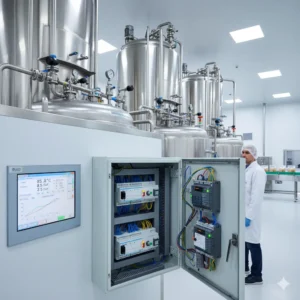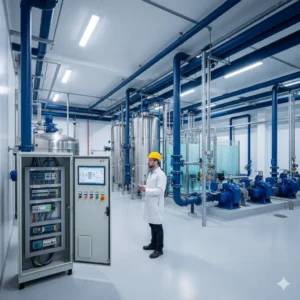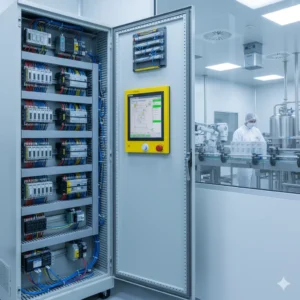Advantages of PLC Automation in Industry
In today’s fast-evolving industrial world, efficiency and reliability are essential for staying competitive. Automation has become the backbone of modern manufacturing, and Programmable Logic Controllers (PLCs) are at the heart of it. They offer a smarter, safer, and more flexible way to control processes.
This article explores the advantages of PLC automation in industry, highlighting how it improves productivity, reduces downtime, and enables seamless integration with advanced technologies like SCADA and IIoT.
Understanding PLC Systems and Their Role in Industrial Automation
A Programmable Logic Controller (PLC) is an industrial digital computer designed to monitor inputs, make decisions based on programmed logic, and control outputs to automate machinery or processes.
Unlike traditional relay-based control systems, PLC systems for process control are built for speed, flexibility, and reliability. They are capable of running 24/7 under harsh environmental conditions such as heat, vibration, or dust.
Because PLCs are reprogrammable, they offer a cost-effective solution for industries that frequently modify or expand production lines. From simple tasks like motor control to complex operations involving entire production units, PLCs are adaptable to almost every industrial need.
Key Advantages of PLC Automation in Industry
Improved Productivity with PLCs
One of the most noticeable advantages of PLC automation in industry is increased productivity.
PLCs execute commands in milliseconds, ensuring that processes are continuous and synchronized. Tasks that previously required manual intervention are now automated, reducing delays and ensuring consistent output quality.
Because PLCs can handle multiple inputs and outputs simultaneously, they minimize production bottlenecks. Over time, this leads to significant improvements in throughput and operational efficiency.
Reduced Downtime and Maintenance
Unexpected downtime is one of the biggest challenges for manufacturers. With PLC automation, this problem can be dramatically reduced.
PLCs are designed for durability and can operate for years without major failures. Their diagnostic functions allow operators to detect faults instantly and take corrective actions before they become serious issues.
Furthermore, since PLCs are modular, replacing or updating specific components doesn’t require complete system shutdown. This modularity not only reduces downtime but also simplifies maintenance schedules.
Flexible and Scalable Automation
Flexibility is a major reason why industries prefer PLC implementation in manufacturing. When production requirements change, engineers can modify the control logic without changing hardware.
For example, if a factory adds a new production line or changes a process sequence, the PLC program can be updated within minutes. This scalability allows businesses to grow and adapt quickly to market demands.
Moreover, as companies expand globally, PLCs support integration across multiple plants, ensuring standardized automation and control.
Cost-Effective Industrial Control Systems
While initial investment in automation may seem high, PLC-based control systems quickly prove their value. Their long lifespan, minimal maintenance needs, and ability to reduce human error translate into substantial cost savings over time.
Because PLCs enhance precision and minimize material waste, industries can achieve higher output using fewer resources. This makes PLC systems one of the most cost-effective industrial control systems available today.
Additionally, as newer versions are backward-compatible, companies can upgrade software without replacing existing hardware, further lowering total ownership cost.
Real-Time Process Monitoring
Real-time monitoring is another defining feature of PLC systems for process control. Operators can track data such as temperature, speed, pressure, and current flow instantaneously.
This live feedback helps identify issues early and enables immediate adjustments, which improves both quality and safety.
When combined with data logging and visualization tools, PLCs provide valuable insights that help in preventive maintenance and performance optimization.
Integration with SCADA and IIoT
Modern industries rely on interconnected systems to maintain efficiency. PLCs play a vital role by communicating with SCADA (Supervisory Control and Data Acquisition) and IIoT (Industrial Internet of Things) platforms.
Through this integration, real-time data from the shop floor can be analyzed remotely, allowing supervisors to make informed decisions.
For instance, operators can monitor multiple plants from a single dashboard, compare productivity metrics, or trigger alerts automatically when parameters exceed set limits. This connectivity not only boosts transparency but also supports predictive maintenance and energy optimization.
Enhanced Reliability and Safety
Reliability is one of the strongest advantages of PLC automation in industry. These systems are engineered for continuous operation and can withstand voltage fluctuations, temperature variations, and mechanical shocks.
Built-in safety features, such as emergency stop functions, interlocks, and redundant systems, ensure that operations remain safe even in critical conditions.
As a result, the risk of accidents, data loss, or production failures is significantly minimized — a major benefit for industries where safety and uptime are top priorities.
Real-World Applications of PLC Automation
 Assembly lines, robotic welding, and paint shops rely heavily on PLCs for precision and speed.
Assembly lines, robotic welding, and paint shops rely heavily on PLCs for precision and speed.
 PLCs maintain temperature, pressure, and mixing consistency, ensuring high-quality products.
PLCs maintain temperature, pressure, and mixing consistency, ensuring high-quality products.
 PLCs regulate pumps, valves, and chemical dosing for safe and efficient operations.
PLCs regulate pumps, valves, and chemical dosing for safe and efficient operations.
 Used for turbine control, load management, and fault monitoring.
Used for turbine control, load management, and fault monitoring.
 PLCs ensure precise control over dosage, packaging, and environmental conditions.
PLCs ensure precise control over dosage, packaging, and environmental conditions.
The Future of PLC-Based Automation
The future of modern automation using PLCs looks promising as industries move toward smart factories and digital transformation.
New-generation PLCs are now equipped with Ethernet connectivity, cloud integration, and AI-based analytics. This means that predictive maintenance, data-driven optimization, and remote operation are becoming standard.
Furthermore, as IIoT adoption grows, PLCs will continue to act as the central link between machines, data, and decision-making systems.
Conclusion: A Smarter Path to Industrial Growth
The advantages of PLC automation in industry are undeniable. From improved productivity and reduced downtime to real-time monitoring and enhanced safety, PLCs offer a reliable foundation for sustainable growth.
Industries that adopt PLC implementation in manufacturing gain more than just efficiency — they gain flexibility, cost savings, and future-ready capabilities.
As the world shifts toward intelligent and connected systems, PLC automation will remain a key driver of innovation and competitiveness across sectors.

